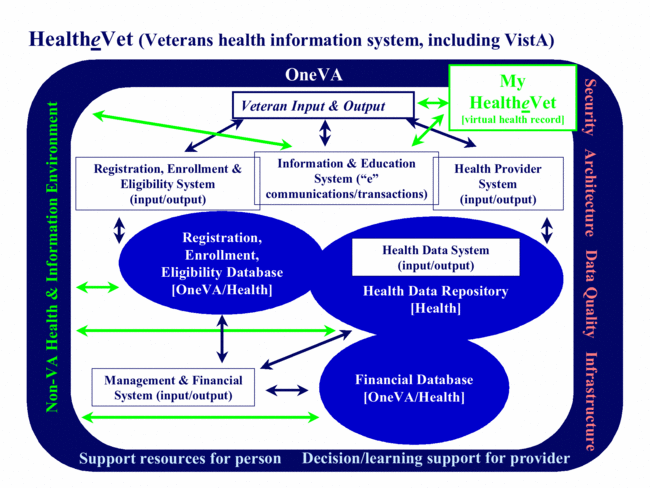WV Introduction
Porting VistA to the OLPC. For introduction to VistA components see VistA Monograph Wiki.
__TOCright__
Introduction
eVet-VistA
VA'S Current and future Computerized Patient Record System
VistA-(Today)
The Department of Veterans Affairs (VA) has had automated information systems in its medical facilities since 1985, beginning with the Decentralized Hospital Computer Program information system, including extensive clinical and administrative capabilities. The Veterans Health Information Systems and Technology Architecture (VistA), supporting ambulatory and inpatient care, delivered significant enhancements to the original system with the release of the Computerized Patient Record System (CPRS) for clinicians in 1997. CPRS provides a single interface for health care providers to review and update a patient's medical record and to place orders, including medications, special procedures, x-rays, patient care nursing orders, diets, and laboratory tests. CPRS is flexible enough to be implemented in a wide variety of settings for a broad spectrum of health care workers and provides a consistent, event-driven, Windows-style interface.
CPRS organizes and presents all relevant data on a patient in a way that directly supports clinical decision-making. The comprehensive cover sheet displays timely, patient-centric information, including active problems, allergies, current medications, recent laboratory results, vital signs, hospitalization, and outpatient clinic history. This information is displayed immediately when a patient is selected and provides an accurate overview of the patient's current status before clinical interventions are ordered. CPRS capabilities include:
- A Real-Time Order Checking System that alerts clinicians during the ordering session that a possible problem could exist if the order is processed;
- A Notification System that immediately alerts clinicians about clinically significant events;
- A Patient Posting System, displayed on every CPRS screen that alerts clinicians to issues related specifically to the patient, including crisis notes, warning, adverse reactions, and advance directives;
- The Clinical Reminder System that allows caregivers to track and improve preventive health care for patients and ensure timely clinical interventions are initiated.
- Remote Data View functionality that allows clinicians to view a patient's medical history from other VA facilities to ensure the clinician has access to all clinically relevant data available at VA facilities.
VistA Imaging is also operational at most VA Medical Centers. VistA Imaging provides a multimedia, on-line patient record that integrates traditional medical chart information with medical images, including x-rays, pathology slides, video views, scanned documents, cardiology exam results, wound photos, dental images, endoscopies, etc. into the patient record.
Bar Code Medication Administration addresses the serious issue of inpatient medication errors by electronically validating and documenting medications for inpatients. It ensures that the patient receives the correct medication in the correct dose, at the correct time, and visually alerts staff when the proper parameters are not met.
HealtheVet Desktop is an application framework that will host the new generation of Veterans Health Administration (VHA) clinical applications. Care Management is the first application to run on the new HealtheVet Desktop and is an enhancement of CPRS designed to assist health care providers to follow-up on clinical interventions that might otherwise be missed. Care Management provides an automated method for tracking follow-up actions/tasks for a panel of patients for a designated period of time. The four perspecitives of Care management are the Clinician Dashboard, the Nursing Dashboard, the Query Tool and the Sign List. Implementation of the Care Management project will improve patient care by:
- Ensuring that appropriate clinical interventions are provided on a timely basis;
- Ensuring that clinical notifications are processed on a timely basis;
- Reducing the amount of time primary care providers spend reviewing individual patient records; and
- Reducing the risk of erroneous data entry
HealtheVet-VistA-(Future)
A strategy has been developed to move the Veterans Health Information Systems toward "HealtheVet", an ideal health information system to support the ideal veterans health system. Collaboratively among the Department, field, and central office leadership and the Chief Information Officer, a proposed strategy has been developed for both VA and Veterans Health Administration needs. The strategy is built around five major systems and integrates five cross-cutting issues:
- The Health Data System [health data repository (HDR)] will create a true longitudinal health care record including data from VA and non-VA sources. The health data system will support research and population analyses, facilitate patient access to data and sharing of information across VHA, and improve data quality and data security.
- Provider Systems support healthcare providers' care for veterans and feed information to VistA today and the HDR in the future. These include CPRS, VistA Imaging, Blood Bank, Pharmacy, Laboratory, Federal Health Information Exchange (FHIE), and Scheduling.
- Management/Financial Systems include four applications that are each ten or more years old and will be replaced: the Financial Management System, Billing and Accounts Receivable (AR), and Fee Basis (paying providers).
- Information and Education Systems with an emphasis on "eHealth" include prescription refills, appointments, fillable forms online, and My HealtheVet (access to health record, on-line health assessment tools; and high quality health information).
- Registration, Enrollment, and Eligibility Systems will be developed as a single, department-wide data system and demographic database that supports registration and eligibility for the three Administrations and makes this information more accessible and consistent.
- Cross-Cutting Issues include the VA and VHA architectures, information security, data quality, and leadership and management. These issues cut across all systems and ensure effective implementation and operations of the major systems.
Graphical Illustration of the HealtheVet-VistA Strategy

Veterans Health Information System, including VistA
